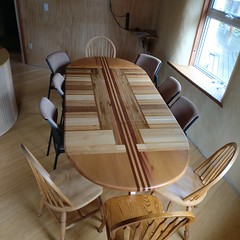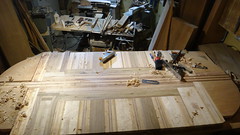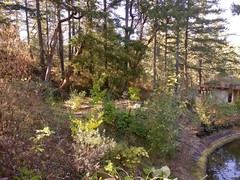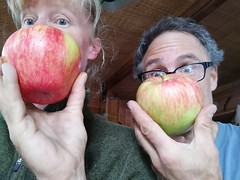Wow, it is Friday already and we have not yet posted our plant profile for this week. And when tomorrow’s open house comes (Saturday from 10am-2pm), whatever will we have to talk about if we don’t post something? (Ann: Lots Gord…we talk about other things too you know…not just plants. We talk about chickens, ducks, and cheese too…maybe even kefir and sauerkraut). This week’s plant profile is a toss up between our three year old Arbequina olives (Olea europa), the replenishing of our tea stock (Camelia sinensis), new oca, the dwindling supply of Sichuan pepper trees (only 3 left)… or our late bearing Japanese Lonicera caerulea varieties emphallocalyx and kamtschatica or HASKAPs for short. (Ann: eyes rolling as Gord spews out his newly learned latin). (Gord: Ann loves when I speak in different languages).
But before we tell you about the plant of the week, we just have to say… What a week! Composting bathrooms being built at a local park/public orchard (Welland Park), more cheese, more plants, (Ann: More cheese), the Ladysmith Garden Club tour (Ann: A very nice tour crashing couple arrived that the Ladysmith group invited to join their tour), plants arriving (Ann: and then Gord leaving me to move all 250 of them out of the sun), and Our Eco-village mega-tour with great people leaving with hugs as they headed on to another amazing place full of stories, Madrona Farm. (Ann: Yeah, then I headed out to my neighbours to milk her goat, swap stories, and return home with more milk…to make more cheese). Did we mention our last shipment of plants… yup, we had under estimated the interest in the edible perennial food systems, and would never have had the stock to make it to June… and left us without our propagating stock… even digging out our extra male fuzzy kiwi out of our garden. (Ann: Males can be so redundant eh?) We have had emails with pictures and questions to identify plants, and recommend options. We love the amount of interest in all the cool things from plants to… did Ann say cheese?.
Oh and not to mention, we observed the success of last year’s roof top squash bed on our steel container, where 150 squash hung off the sides (Ann: Gord always exaggerates…it was 120)… so this year we have planted the house roof with butternuts and watermelon (Ann: note…Ann planted them…ok Gord carries up the bales and most of the buckets). Are we crazy? Only Ann! (Ann: Only Gord)(Guess who’s writing this update?). (Ann: Ann’s editing).
We have decided on profiling the plant which seems to have a lot of partial information on it … so here it is…wtf? (Ann: Want The Facts?)
And one last piece of info… here is the up to date online list of plant availability and pricing .
Honey Berry – Haskap – (Lonicera caerulea spp.)
o Lonicera caerulea var. edulis – Russian (Early)
o Lonicera caerulea var. emphyllocalyx – Japan (Late)
o Lonicera caerulea var. kamtschatica – Japan (Late)
Why Honey Berry or Haskap?
First off why the different names? The Russian varieties, have been referred to as honey berry, and the Japanese have been called haskap. The two varieties have different characteristics, but what both do have in common is that they are an early edible blue coloured berry that comes from a beautiful understory bush, that can be grown in our climate. It is hard not to turn away from early berries.
L. cerulean var. edulis – Russian/Canadian Cultivars EARLY SEASON
These are notably the hardier cultivars that can handle the extreme cold in Canada and Russia, and thus they have been a berry that has been bred to live through a Saskatchewan winter. These varieties ripen early. Our recommendation for the early varieties is to plant in areas where they get early morning sun, avoid the frost pockets.
- Tundra – grows 5-6 ft tall, berries are firm and thus makes them ideal for machine harvesting, but great for the home garden, and has a sweet-tangy flavour. Borealis and Tundra do not pollinate each other well – Pollinated by Honeybee or Berry Blue. More Info
- Borealis – grows 5-6 ft tall. The SWEETEST honeyberry, high yield large fruit. The berries are soft, plump, boxy and largest. It has large fruit and is the sweetest cultivar though it does tend to bleed. Excellent fresh eating. Tundra is a poor pollinator for Borealis, Honey bee and Berry Blue are the pollinators. More Info
- Honeybee – a tall pollinator plant suited for Tundra and Borealis. Berries are tart and used in jams and juices… they are the least tart of the Russian pollinators. More Info
L. caerulea var. emphyllocalyx and kamtschatica – Japan Cultivars LATE SEASON
These come from Northern Japan, are 3 -4 weeks later than the Russian/Canadian cultivars, and are well suited for the coastal climate of the west coast from Oregon on north.
- Blue Hokkaido – upright 4-5 ft. tall growth habit and very large, sweet-tart, crisp and flavorful, dark blue berries. Bloom in March, ripen in June.
- Blue Moon – 2-3 ft tall and wide. Very cold-tolerant — withstands temperatures as low as -40°F. This hardy variety features lovely dark green foliage. Good for fresh eating or making preserves. Full sun or partial shade. Best pollinator: Blue Velvet. Blooms March, ripens May-June.
- Blue Pagoda – Sweet berries. Best pollination with Blue Velvet. Blooms March, ripens May-June
- Blue Velvet – 4 ft tall by 5 ft wide compact spreading A unique variety, distinguished by its attractive, grayish-green, velvety foliage and its very large, sweet-tart and flavorful, medium-blue berries. Grows well in cold regions, it is also a particularly good choice for Maritime Northwest gardeners.Large crops of very large tasty berries. Cold-tolerant. Good for fresh eating or making preserves. Best pollinator: Blue Moon. Blooms March, ripens May-June.
- Blue Pacific – 2-3 feet tall and wide. Actually an L. caerulea edulis. A reliable producer west of the Cascades and in other regions of North America. Bloom March, ripens May-June
- Blue Mist – 2-3 feet tall 3-4 ft wide. Heavy producer of large sweet tart berries. Blooms March, ripens May-June.
Growth
Generally they all will grow in part shade to full sun, though we recommend that if you live in an area with hot summers, as we do (in summer we are 5-7C hotter than Victoria), to give them protection from the heat. Our other recommendation is to plant the early ones outside of frost pockets, where frost does not impact the bloom or the pollinators, thus where they get early sun and where the pollinators won’t get chilled. As for the late season, plant where you wish.
Edible
The descriptions above lay out the edibility… early berries that range from sweet to tart. Some are firmer and thus if you are so incline to use a machine to harvest… they’ll be great though I suspect all will be loving hand picked and eaten with enthusiasm. The sweeter are great fresh off the bush, the tart ones mostly dedicated as the pollinators, are great for juice and wines or pies.










I have been stressing about how to go about getting another haskap since I do not know what species I already have. One is a pollinator for sure. When I purchased, there were only three kinds to choose form so I got one of each. The pollinator stayed tiny like a dwarf. So, this year, to augment what I have, I got a big plant that is as high as my knees, in a 3 gallon pot, already has some berries, and it says Tundra/Cinderella. How can it be both? It seems productive at such a small size but it looks like it will grow big, based on the heavy stems and the large collection of trunks. But, is there a chance I will wait a few years and discover there is n pollination taking place? Wish I had saved the tags from the other bushes. Did not expect such a conundrum. I would love an answer if you are able. If not, thank you for the nice blog.
Tundra (and Borealis are producers. If you come across Berry Blue or Honeybee these are pollinators that will work well. Many Hands Farn in Duncan has the russian cultivars you have and can supply an additional pollinator. They are on Westhome Rd. Kim and Curtis Robinson. Cheers
Great guide!